|
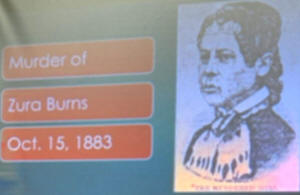
Donath provided a thorough look at the murder of Zura
Burns. Zura Burns was born in Missouri, which was also Zura’s real
first name. She was a seamstress and domestic in the house of Orin
Carpenter, who figures highly in this drama.
When Burns came to work for the Carpenters she was living in Lincoln
with her married sister. The sister and her family eventually moved
to the Dakotas. Donath said Burns had no roots or family in the area
once the sister moved.
In the early morning hours of Monday, October 15, 1883, Mrs. Patrick
Dewitt was making her way through town to her family’s farm ground
north of town. Mrs. Dewitt came across Zura Burns’ body, and she
screamed, which brought others out.

The sheriff and coroner were soon notified, and they
called two doctors to come out to the scene. They all started their
investigation. Initially, Donath said they did not know whose body
it was.
The woman’s throat had been cut deeply, so she had bled out. She
also had head injuries from a blunt instrument, which rendered her
unconscious.
When they moved the body once the scene had been examined, Donath
said many people had walked through the area. There were footprints
all over the place, so it was hard to tell whose footprints were
whose.

Edward Rottenberg drew a sketch of the murder scene
for the court to view and the location of the body is marked with a
B. Donath said the road was near Union Street, Brainard’s Orchard
and 17th Street. Today, 17th Street is known as Woodlawn Road.
An 80-acre cornfield was also nearby. Mrs. Dewitt was headed to the
Dewitt Patch when she discovered Burns’ body north of 17th Street
and west of Union. Donath is not sure of the exact location since
there is no scale on the sketch.
After the body was taken to the coroner’s office for an autopsy,
doctors discovered Burns was four months pregnant. Donath said the
coroner decided he better get a coroner’s jury going.

In the coroner’s office, Burns’ body was laid out for
identification. One young man who came in was what Donath said we
would call a “bus” driver at the railroad stations. The driver
recalled bringing Zura Burns to the Lincoln House that Saturday
morning.
Another person who came in to look at the body thought it looked
like the young woman who worked for the Carpenter family. The women
in the Carpenter family soon came down. Donath said they identified
her as Zura Burns.
The Investigation
Sheriff William Wendell, Coroner John T. Boyden, Dr. L.L. Leeds and
Dr. Katherine Miller were all involved in the investigation. The
coroner pulled together a jury of businessmen.
When Burns’ family was notified, Donath said the father came up from
St. Elmo to Lincoln. Zura’s brother and sister soon arrived too.
They all came to attend the hearings.
The coroner pulled a jury together. Donath said over 60 people were
interviewed. Those involved in the investigation pulled in anyone
with possible information on the crime.
Though all the evidence was circumstantial and did not point to
anyone, Donath said Orin Carpenter’s name came up more often during
interviews.
However, Orin Carpenter was not the only suspect. Other suspects
included Burns’ fiancé Thomas Dukes and Dow Cubbage, who Burns had
been sending letters to. The bus driver was another suspect.
Also on the suspect list was depot newspaper seller Burt Carter from
Decatur. Carter spent quite a bit of time with Zura Burns. Burns
often stayed with a woman in Decatur who apparently was a madame.
The investigation lasted from October 17th until November 1st.
through the inquest. At the end of the inquest, Donath said the
jurors had a verdict. They determined some sharp instrument had
caused Burns’ death.
States’ Attorney Randolph Forrest was out of town when the incident
happened and was not yet back when they needed a prosecutor. Donath
E.D. Blinn stepped into the role until Forrest could return.

Donath said there was a lot of pressure on the
prosecution to get a murder conviction. There had been 38 murders
between 1839 (when the county was formed) and 1883. In all those
years, Donath said there had been only one conviction. The people of
Logan County were up in arms and wanted to see someone pay.
In August 1882, Donath said there had been a triple murder in Mt.
Pulaski of a farmer and two farmhands, who were all killed by having
their throats cut. This murder was solved in 1884 after Burns’
murder had happened.
The Inquest

Many people were involved in the inquest including
Justice of the Peace was Jacob T. Rudolph, Coroner Boyden, Sheriff
Wendell and State’s Attorney Forrest assisted by Edward Blinn.
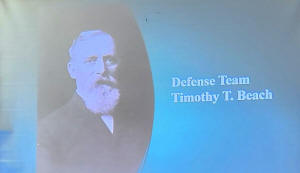

Timothy Beach and Joseph Hodnett were on the defense
team that represented Carpenter. Donath said they brought in Edmund
Lynch because he was a good speaker.
Dr. Leeds and Dr. Miller did the Post-Mortem and determined the
murder took place between midnight Sunday and 3 a.m. Monday, so
there was a short window of time. Unfortunately, Donath said
investigators could not place any suspects in the short window of
time the murder occurred.
Over 60 witnesses were interviewed. Donath said they came out of the
woodwork.
During the investigation, the county put up a $1000 reward for
information leading to an arrest. Others added in money, so Donath
said it made the reward around $1500.
Private detectives then started coming out of the woodwork. Donath
said most of them were not very good. Two of them used clairvoyants
to get their information.
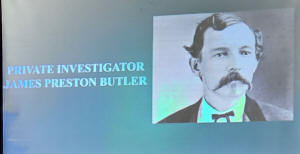
Private Investigator Preston Butler, who was working
for the prosecution, searched Carpenter’s buggy and found some
hairpins in it. Donath said those hairpins may have belonged to his
mother, his wife, daughters or their friends who had ridden the
buggy.
Something else Donath said Butler found in the buggy was what
appeared to be a small bloodstain. After Butler showed the
bloodstain to Judge Rudolph, he said Carpenter needed to be
arrested. Carpenter was then arrested at his place of business.
Important Locations
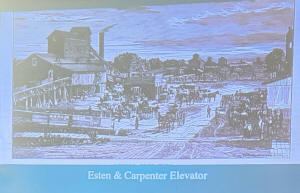
Carpenter was part owner of the Esten and Carpenter
Elevator near Chicago Street and Broadway Street. Donath said
Carpenter’s office played a critical role in the investigation.
Because Carpenter was buying out Martiline’s Elevator in Hartsburg,
Donath said Carpenter worked many late nights in the office. The
weekend of the murder Carpenter was working late.
At the time the body was found on Monday, Carpenter was headed for
Hartsburg.
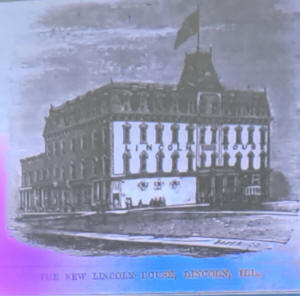
On the Saturday before the murder, Donath said Zura
Burns had gone to the office to see Carpenter and talk to him about
where her sister was. Carpenter was to pay Burns for work she had
done. After talking to Carpenter, Burns went to the New Lincoln
House nearby.
[to top of second column] |

When the whip, hairpins and rings
were tested for bloodstains by specialists in Chicago, Donath
said the results were inconclusive.
At that point, Donath said nobody had
been bound over to the grand jury to be the prime suspect for the
murder. Carpenter was in jail, and they had already had the
coroner’s jury.
There was a preliminary hearing for the grand jury, which Donath
said was presided over by Judge Lyman Lacey of Mason City. The same
60 witnesses were called, and the evidence was still circumstantial,
but Lacey wanted the grand jury to look at everything. Lacey then
bound Carpenter over to the grand jury, which would be in January
1884.
The Grand Jury
As the grand jury convened, Donath said news of the activity was
very secret. No one was let into the jury room and very little was
in the papers. However, the grand jury returned with a five-count
indictment against Carpenter.
The defense team knew Carpenter would not get a fair trial in Logan
County. Donath said they changed the venue to Menard County due to
the safety of the jurors and others in Logan County. In March 1884,
the trial convened in Petersburg.
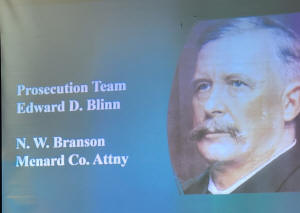

Several court officers were involved in helping
negotiate through the system. Donath said they included Judge Lacey,
State’s Attorney Forrest and Menard County Attorney S. S. Woodward.
On the prosecution team were attorneys Edward D. Blinn of Logan
County and N.W. Bronson of Menard County.

Donath said the defense team was made up of Timothy
T. Beach, Joseph Hodnett, Edmund Lynch and Menard County’s T.W.
McNeely.

The defense lawyers asked potential jurors if they
would convict based on circumstantial evidence. They interviewed 88
jurors in order to choose 12. The jurors chosen said they would not
convict on circumstantial evidence.
In this trial, Donath said the testimony was identical to the
testimony in other hearings. Nothing new had developed in that time
and nothing else was found that would bring other suspects in. He
said everyone [thought they] knew the verdict before the trial
started. Reporters said only one conclusion could come out of it.
There were two weeks of testimony by more than 100 witnesses.
Forrest spoke for four or five hours in both opening and closing.
Donath said he loved to hear himself talk.
After long overnight deliberations, Donath said the first vote was
7-5 for acquittal. Jurors kept discussing the case and the next vote
was 10-2. Donath said by 3 a.m., the final vote was unanimous for
the acquittal of Orin Carpenter.

The judge opened court, read the not guilty verdict
and dismissed the jury.
Donath said that would usually be the end of everything, but the
judge ran into the court of public opinion. A notice of a mass
meeting at the courthouse was posted in all the papers in Lincoln.
The newspapers said thousands showed up. In the old courthouse,
Donath said only 200 could get in.
A committee of seven was selected to write some resolutions against
Carpenter. Donath said there were also speeches by Carpenter’s
minister and by Mr. Burns, who was a heavy drinker and unstable.
These men publicly condemned Carpenter.
Several resolutions were adopted, and one resolution said Carpenter
must leave the county without delay. Donath said a committee of 50
was selected to deliver the resolutions to Carpenter.
This committee walked down Broadway, up Union and down Ninth Street,
to Carpenter’s house. They selected one man to hand deliver the
resolutions to Carpenter, who met him on the porch. The man read the
resolutions to Carpenter, but Donath said Carpenter told the man “I
do not recognize your authority in this matter. Because Carpenter
would not accept the resolutions, the man laid them on the porch and
left.
Though the group had agreed there would be no violence, Donath said
the sheriff had contacted the state because there had been talk
about lynching Carpenter. The militia was available if needed.
Carpenter refused to leave because he wanted to make his own
decision. However, Donath said one resolution stated if Carpenter
stayed, they would make sure no farmer in the county would bring
grain to Carpenter’s elevator anymore.
Since losing so much business would have also ruined his good friend
and partner Esten, Carpenter decided to sell off all his properties
and leave. Donath said Carpenter and his family then moved to Blunt,
Dakota where they had good friends. The Carpenter family later moved
to Sioux Falls, where they had a farm.
In December 1884, Carpenter came back to Lincoln to finish up some
business. Donath said Mr. Burns had heard Carpenter was in town.
Burns shot at Carpenter while Carpenter met with Uriah Hill. The
shot hit the iron façade of the building and bounced off.
When Burns ran down the street claiming he had killed Carpenter,
Donath said the police did not try to catch Burns.
After 1884, Carpenter did not return to Lincoln for 25 years.
Even Donath is unsure of whether Carpenter was truly guilty.
The case became famous all around the United States from the
Atlantic Ocean to the Pacific Ocean. Donath said the Decatur Herald
Review had great coverage of the trial and did not leave out
details. He was disappointed in the papers who covered the trial in
Petersburg because so many details were left out.
Over the years, Donath said four publications about the case have
come out. One is a “lurid novel” by Charles James titled Zura Burns,
or the Fatal Step. Another is a case study by Beverly Smith titled
The Murder of Zura Burns, 1883: A Case Study of a Homicide in
Lincoln.
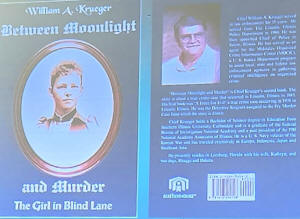
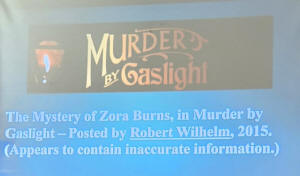
There is also a novel by William Krueger titled
Between Moonlight Murder: The Girl in Blind Lane. Finally, there is
a 2015 blog post by Robert Wilhelm called the Mystery of Zora Burns,
in Murder by Gaslight. Donath said the blog appears to have
inaccurate information. Donath said Wilhelm’s sources were from
newspapers back East.
Once Donath finished his presentation there were several questions.

LCGHS member Ellen Dobihal asked if the train depot
was near Carpenter’s grain elevator and Donath said yes.
The question LCGHS member Curt Fox had was whether the murder weapon
was found.
Donath said not only was the murder weapon not found, but none of
the items Burns had with her were ever found.
From Donath’s perspective, there was a lack of blood evidence on
Carpenter or in the buggy. He said the tracks near the body
apparently did not match Carpenter’s buggy tracks. Donath felt even
the timing of the murder did not fit.
As for who killed Zura Burns, some members thought it may have been
her fiancé, the minister or the father of the baby.
Sadly, we may never know exactly what happened that night or whether
Orin Carpenter killed Zura Burns.
The annual Logan County and Genealogical Historical Society dinner
and meeting will be held Monday, November 20 at Daphnes’ Restaurant
at 6:30 p.m. Those attending will hear a presentation about the
Atlanta, Illinois Giants Museum.
For those wanting to attend the dinner, reservation forms can be
picked up at the LCGHS building and must be turned in by November
10.
[Angela Reiners]
 |